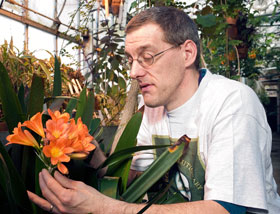  |
| HOME | THIS ISSUE | CALENDAR | GRANTS | BACK ISSUES | < BACK | NEXT > |
Biology greenhouse open to the public by Sherry Fisher - January 29, 2007 |
||||
| It may be gray and blustery outside, but the delicate pink blooms of the Sacred Flower of the Incas can transport you to Peru. Nearby, tiny white flowers poke through the bark of a cacao tree, and a vanilla orchid bean climbs up a brick wall. These plants and hundreds more are housed in the ecology and evolutionary biology greenhouse, nestled behind the Torrey Life Sciences Building. The greenhouse, which has 10 rooms, is home to some 2,300 species of plants, representing ecosystems from the tropics to the desert. Each room is characterized by particular groups of plant species that flourish in similar environments. The bulk of the collection is tropical. "As we move through the dreary winter months, we'd like to remind people that the greenhouses are open to the public," says Clinton Morse, plant growth facilities manager. The greenhouses are open from 8 a.m. to 4 p.m. Monday through Friday, except for major holidays. In addition, through April, the greenhouses will be open Saturdays from 10 a.m. to 2 p.m. Student docents will be available to answer general questions. "The living plant collections at UConn are among the most diverse collections in the country," Morse says. "We have plants that are economically important, plants that are strange or odd, and ancient species that are nearly extinct. "Our greenhouse is bigger than the islands some of these plants grow on," he adds. The collections - coming from as far away as Australia, Bolivia, and China - represent every continent except Antarctica. They support the University's teaching, research, and outreach activities. "Every plant has a story," Morse says, "a plan of adaptation for survival." He points out a Tree Tumbo, a two-leaf plant sitting in a deep pot. Native to Southern Angola and Southwestern African deserts, the plant can live for 1,500 years, he notes: "It gets its moisture from sea-fog dew." Morse then turns to a Roridula dentata , or bug plant. "This has sticky hairs and secretes a fragrance that attracts insects," he explains. "Assassin bugs, which are not trapped by the sticky hairs, move around freely and feed on the captured insects. The plant is pseudo-carnivorous."
In the same room, pots of Lithops , commonly known as "living stones," line a counter. "In their natural habitat they mimic round pebbles," Morse says. They blend in with stones as a means of protection. "People should come to enjoy seeing the plants and appreciating the diversity," he says. "They can better realize that it's worth protecting." Susan Letcher, a docent at the greenhouse, says she enjoys sharing the collection with the public: "Plants have a fascinating behind-the-scenes life. I like sharing that." A eighth-semester doctoral student in ecology and evolutionary biology, Letcher says visitors find the carnivorous plants - such as the Venus Flytrap - of special interest. "It's the idea that a plant can trap and feed on an animal," she says. "They also like ant plants, where there's a symbiotic relationship between the ant and the plant. It's a fascinating system. For instance, some acacia trees excrete food bodies from their leaves and produce hollow thorns where the ants live. In turn, the ants protect the plants from other predators," she says. Letcher spends six months of the year in Costa Rica studying tropical forest regeneration. Visitors are advised to park in the North Parking Garage. After exiting the garage, walk up North Eagleville Road and take the stairway down between the Biology/ Physics and Torrey Life Sciences buildings. Enter the greenhouses via the doorway off the plaza area. Information about the collections and details on the plants in the collections can be found on the web site. |
| ADVANCE HOME |

